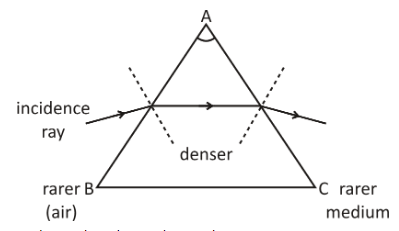
Answer
422.1k+ views
Hint:The incident ray is a light ray that strikes the surface. The angle of incidence between this ray and the perpendicular or natural surface is the angle of incidence. It is refracted against the usual as an incident ray of light passes a prism. This refracted ray then strikes the other side of the prism and deviates away from the usual and leaves the glass prism to enter the air, i.e. from one medium to the other. This ray that leaves the prism is called an emerging ray.
Complete answer:

A ray of light which is incident on the surface of a glass prism goes from rarer to denser medium. So, the ray will bend towards the normal after refraction. Again the ray of light is going from denser to rarer medium. So, the ray of light will bend away from the normal while coming out the glass prism.
An angle of deviation will be formed between the incidence ray and emergent ray. The different direction represents the incident ray and the emerging ray after going through the prism. The emerging ray still bends at an angle with the incident ray, called the angle of deviation, when refracting a ray of light through the prism. The emerging ray bends at an angle to the direction of the incident ray should then be the correct statement.
Hence, option B is correct.
Note:The emergent ray and the incident ray are parallel on a glass slab. So, we should not be confused between the glass slab and prism. In a prism the angle of incidence and angle of refraction are different.Prism is a triangular glass, which has two triangular bases and three rectangular lateral surfaces.The unique shape of the prism makes the emergent ray bend at an angle to the direction of the incident ray and this angle is known as the angle of deviation.
Complete answer:

A ray of light which is incident on the surface of a glass prism goes from rarer to denser medium. So, the ray will bend towards the normal after refraction. Again the ray of light is going from denser to rarer medium. So, the ray of light will bend away from the normal while coming out the glass prism.
An angle of deviation will be formed between the incidence ray and emergent ray. The different direction represents the incident ray and the emerging ray after going through the prism. The emerging ray still bends at an angle with the incident ray, called the angle of deviation, when refracting a ray of light through the prism. The emerging ray bends at an angle to the direction of the incident ray should then be the correct statement.
Hence, option B is correct.
Note:The emergent ray and the incident ray are parallel on a glass slab. So, we should not be confused between the glass slab and prism. In a prism the angle of incidence and angle of refraction are different.Prism is a triangular glass, which has two triangular bases and three rectangular lateral surfaces.The unique shape of the prism makes the emergent ray bend at an angle to the direction of the incident ray and this angle is known as the angle of deviation.
Recently Updated Pages
How many sigma and pi bonds are present in HCequiv class 11 chemistry CBSE

Mark and label the given geoinformation on the outline class 11 social science CBSE

When people say No pun intended what does that mea class 8 english CBSE

Name the states which share their boundary with Indias class 9 social science CBSE

Give an account of the Northern Plains of India class 9 social science CBSE

Change the following sentences into negative and interrogative class 10 english CBSE

Trending doubts
Difference Between Plant Cell and Animal Cell

Difference between Prokaryotic cell and Eukaryotic class 11 biology CBSE

Fill the blanks with the suitable prepositions 1 The class 9 english CBSE

Differentiate between homogeneous and heterogeneous class 12 chemistry CBSE

Which are the Top 10 Largest Countries of the World?

One cusec is equal to how many liters class 8 maths CBSE

Give 10 examples for herbs , shrubs , climbers , creepers

The mountain range which stretches from Gujarat in class 10 social science CBSE

The Equation xxx + 2 is Satisfied when x is Equal to Class 10 Maths



